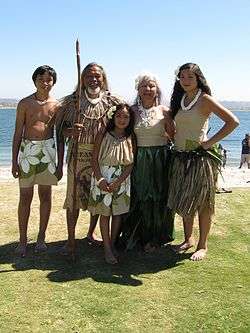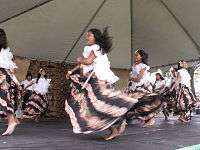Culture of Guam

The culture of Guam reflects traditional Chamorro customs in a combination of indigenous pre-Hispanic forms, as well as American, Filipino, Spanish and Mexican traditions.[1] The Chamorro people have lived on the Micronesian island of Guam for nearly 4000 years, and have cuisine, dance, fashion, games, language, music, and songs of their own.
Background and customs

The island’s original community is of Chamorro natives who have inhabited Guam for almost 4000 years.[2] They had their own language akin to the languages of Indonesia and Philippines. The Spanish later called them Chamorros, a derivative of the local word Chamurre (meaning of Chamorri is "noble race"). They began to grow rice on the island.[3] Western people came to the island from the 16th century and wrote about the culture of these people. Many scientists (including ethnologists, doctors, botanists, archeologists) came to Guam from Spain, Russia, France to study from the 1700s, apart from Spanish governors who had written on the local people. Many of their collections are now in the Guam Museum.[4]
Dress


Early navigators and missionaries described the aboriginal inhabitants of Guam. The men wore their hair loose or coiled in a knot on top of the head, though there are also records of the men shaving the head, with the exception of a section about a finger long, which they left on the crown. Some of them were bearded.[5] They also wore hats called akgak made out of pendanus plant. Carrying a carved walking stick was a style among young men. Men built houses and canoes and fished, hunted birds, fruit bats and crabs, and grew their own crops.[6]
Women's hair was worn long, touching the ground. The lower half covering of the women was a small apron-like garment made of the inner bark of a tree.[5] They also wore a top called the tifi made out of gunot while men remained bare-chested due to hot climatic conditions.[6] The women occupied themselves with weaving baskets, mats, and hats of pandanus leaves, and doing other necessary work about the house.[5] Women decorated themselves with flowers and belts made of coconuts as jewelry over their skirts and also a head dress made of tortoise shells. Women took care of the domestic chores, but were also involved in fishing in reefs and collecting breadfruit called dokdok from the forest. [7]
Marriage and festivals
Before marriage, it was customary for young men to live in concubinage with young women, whom they purchased from their parents by presents. Frequently a number of young men and young women would live together in a large public, house, as is the custom among the Igorot of Luzon. After marriage, a husband contented himself with one wife, and a wife with one husband, at a time. Divorces were noted as being frequent, with the children and the household property staying with the wife.[8]
Festivals were celebrated with the men and women collecting in separate groups, forming semi-circles. They would sing and chant their legends and fables. Sometimes these songs would be sung with treble, contralto, and falsetto singers in a three-part harmony. The songs were accompanied by certain gestures and movements of the body. Women used rattles and castanets made of shells to create music.[9]
Religion
Historically, the people of Guam were known to be superstitious. They venerated the bones of their ancestors, keeping the skulls in their houses in small baskets, and practicing incantations before them when it was desired to attain certain objects. The spirits of the dead were called aniti, and were supposed to dwell in the forests, often visiting the villages, causing bad dreams and having especial sway over the fisheries. People dying a violent death went to a place called Zazarraguan. Those dying a natural death were said to have gone to a subterranean paradise containing coconut groves and banana plantations, as well as sugar cane and other fruits.[10]
Dominican Sisters, Sisters of the Good Shepherd, Guam Buddhism Society, Muslim Association of Guam, and the Redemptoris Mater Seminary are religious institutions present in modern-day Guam. Ancestral worship is still mentioned.[11]
Cuisine

Historically, the inhabitants of Guam ate fish, fowls, rice, breadfruit, taro, yams, bananas, coconuts, used in several dishes. They cooked by means of heated stones in a heated pit, much like the method used by the modern Polynesians. The principal plants introduced by the missionaries were maize, tobacco, oranges, lemons, limes, pineapples, cashew nuts, peanuts, egg plants, tomatoes, and several species of Annona, besides a number of leguminous vegetables and garden herbs. Coffee and cacao were introduced later.[12]
The modern-day cuisine of Guam is fusion of those of the indigenous tribes of Chamorro, the Philippines, Pacific Islanders, Asians and whites. Spanish colonialism lasting 200 years also has a strong influence on the cuisine blended with the present American influence. Some of the popular dishes are the Chorizo Breakfast Bowl, the Jamaican Grill, red rice as side dish cooked with red seeds of the achiote tree, and a Filipino-inspired dessert called the Banana Lumpia.[13] P. mariannus mariannus is a feature of traditional Chamorro cuisine.[14] Other local ingredients in Guam's cuisine include fresh fish, such as tuna, as well as breadfruit, coconut, papaya, taro, and yams.[15] Chicharrón, Guyuria, Roskette, and Kalamai are typical dishes.
Architecture

Historically, Chamorro houses were raised on wooden posts or pillars of stone (called latte), and thatched with palm leaves. Their boats were kept in pillar-supported sheds near the water.[9] The latte stones are stone pillars built integral to every house on the Guam island and also in all other Marianas islands.[16] The latte stone houses built length wise were narrow with a rising roof with long rafters. The rafters were extended to the ground level and buried in the ground as a protection against cyclonic winds. Hardwood (of ifil or seeded breadfruit trees or palo maria) formed the main framework of the houses with woven palm leaves covering the sides. The flooring was made of wood from betel nut trees or of split bamboo. Usually the kitchen was made as a separate house. [17] Most of the 180 or so villages in Guam were mostly destroyed during the Spanish-Chamorro war between 1670 and 1695, and only the latte from 20 houses still remain, where remnants of pottery, shell tools and stone are scattered.[18]In modern times the latte stone has become a symbol of Chamorro identity and concrete lattes have been fashioned into new buildings, while actual latte stones can be seen incorporated into residential landscaping.
Art
Pottery
Chamorro pottery is a local ceramic art form which according to archaeological finds dates back to more than 3,000 years. Items were in the form of domestic kitchen ware were handcrafted with geometric designs with lime impressions. During the Latte Period (800 AD–1521 AD), ceramics were made with red clay mixed with volcanic sand. These were decorated on the surface along the rim but were smaller in size compared to the pre-Latte ware. They were also designed with a round or cone-shaped base with small openings to facilitate cooking. However, during the Spanish colonial rule this craft was discontinued and imported ceramics came to be used. In the mid-1960s, the University of Guam has promoted this form of craft work, and it is now a specialized art form of Guam.[19]
Painting
Painting is a recent practice which has evolved in Guam since the 1980s. Guam International Airport has one of the largest collection of paintings by local artists on display at the arrival and departure gates, as does the business college of the University of Guam.[20] Some of the murals done by painter Sal Bidaure are a two-story level mural on the Bank of Hawaii and another that is done on the concrete retaining wall near the Hilton hotel. Contemporary paintings by many artists are seen in many prominent buildings throughout the island. Some of the well-known contemporary artists are Mark Dell’Isola, Vivian Chargulaf, Monica Baza and Ric R. Castro.[20]
See also
References
 This article incorporates text from a work in the public domain: W. E. Stafford's "Guam, an Account of Its Discovery and Reduction, Physical Geography and Natural History: And the Social and Economic Conditions on the Island During the First Year of the American Occupation" (1912)
This article incorporates text from a work in the public domain: W. E. Stafford's "Guam, an Account of Its Discovery and Reduction, Physical Geography and Natural History: And the Social and Economic Conditions on the Island During the First Year of the American Occupation" (1912)
- ↑ Wuerch & Ballendorf 1994, p. 44.
- ↑ Cunningham & Beaty 2001, p. 5-6.
- ↑ Cunningham & Beaty 2001, p. 5.
- ↑ Cunningham & Beaty 2001, pp. 13-14.
- 1 2 3 Safford 1912, p. 9.
- 1 2 Cunningham & Beaty 2001, pp. 19-20.
- ↑ Cunningham & Beaty 2001, pp. 20-1.
- ↑ Safford 1912, p. 10.
- 1 2 Safford 1912, p. 12.
- ↑ Safford 1912, p. 11.
- ↑ Liston, Clark & Alexander 2011, p. 55.
- ↑ Safford 1912, pp. 13–14.
- ↑ "Guam: The best place you never considered going to". BBC.com. 7 February 2011. Retrieved 21 October 2013.
- ↑ Quammen 2012, p. 131-132.
- ↑ Hanauer 2001, p. 13.
- ↑ "Contents of a Latte Village". Guampedia. Retrieved 19 October 2013.
- ↑ Cunningham & Beaty 2001, pp. 26-27.
- ↑ Cunningham & Beaty 2001, p. 28.
- ↑ "Ceramics". Guampedia.com. Retrieved 20 October 2013.
- 1 2 "Painting". Guampedia.com. Retrieved 21 October 2013.
- Bibliography
- Cunningham, Lawrence J.; Beaty, Janice J. (1 January 2001). A History of Guam. Bess Press. ISBN 978-1-57306-068-4.
- Hanauer, Eric (2001). Diving Micronesia. Aqua Quest Publications, Inc. ISBN 978-1-881652-19-9.
- Liston, Jolie; Clark, Geoffrey Richard; Alexander, Dwight (2011). Pacific Island Heritage: Archaeology, Identity & Community. ANU E Press. ISBN 978-1-921862-48-9.
- Quammen, David (23 October 2012). "One Man's Meat: The Dilemma of Fruit Bat Cuisine on the Island of Guam". The Boilerplate Rhino: Nature in the Eye of the Beholder. Scribner. ISBN 978-1-4391-2543-4.
- Safford, William Edwin (1912). Guam, an Account of Its Discovery and Reduction, Physical Geography and Natural History: And the Social and Economic Conditions on the Island During the First Year of the American Occupation (Public domain ed.). General Books.
- Wuerch, William L.; Ballendorf, Dirk Anthony (1 January 1994). Historical Dictionary of Guam and Micronesia. Scarecrow Press. ISBN 978-0-8108-2858-2.
External links
![]() Media related to Culture of Guam at Wikimedia Commons
Media related to Culture of Guam at Wikimedia Commons